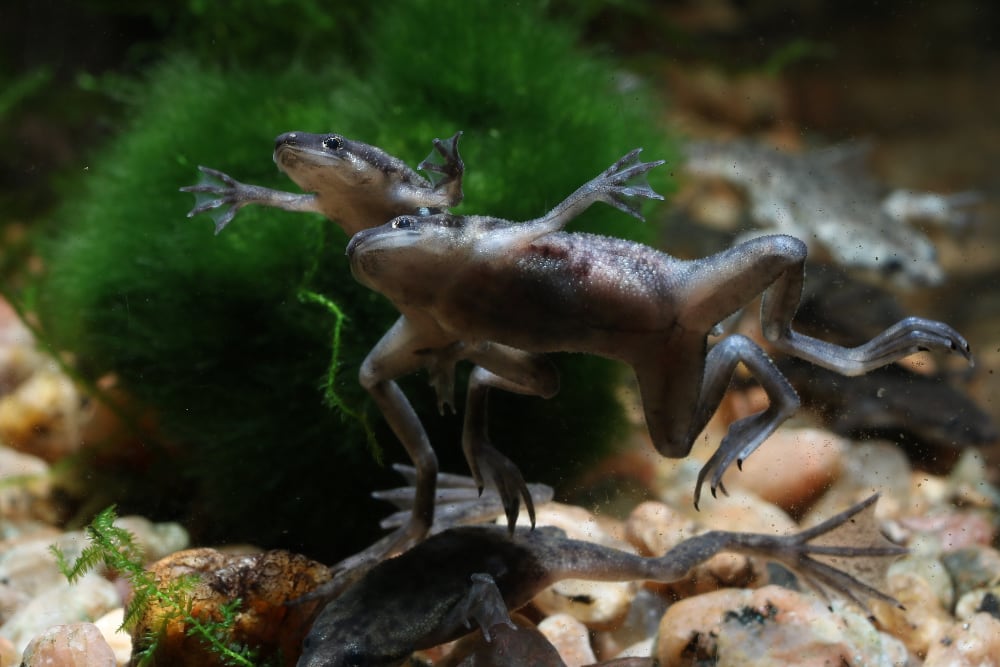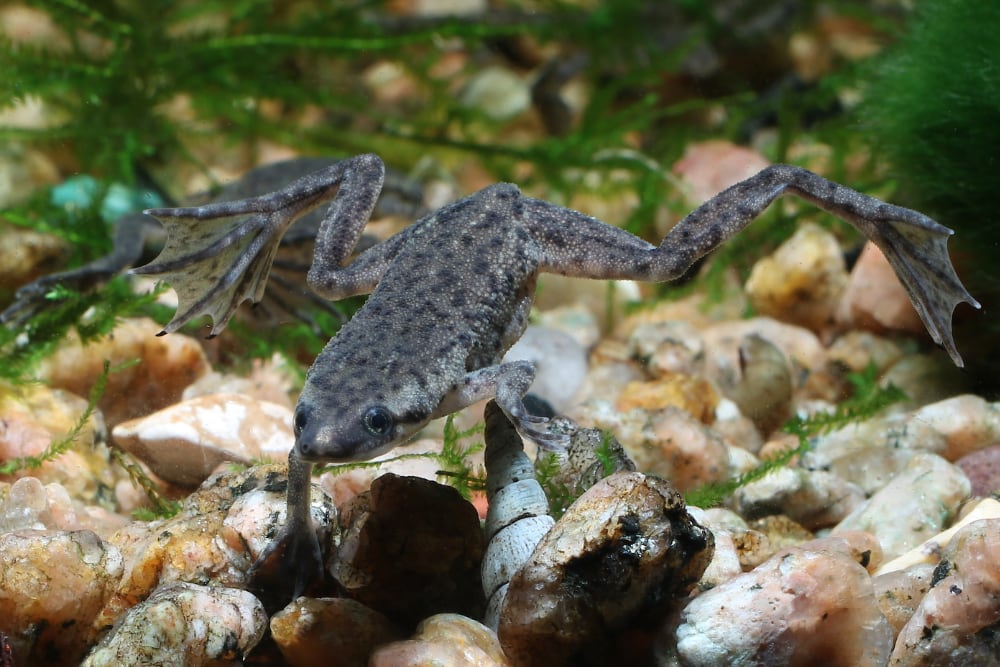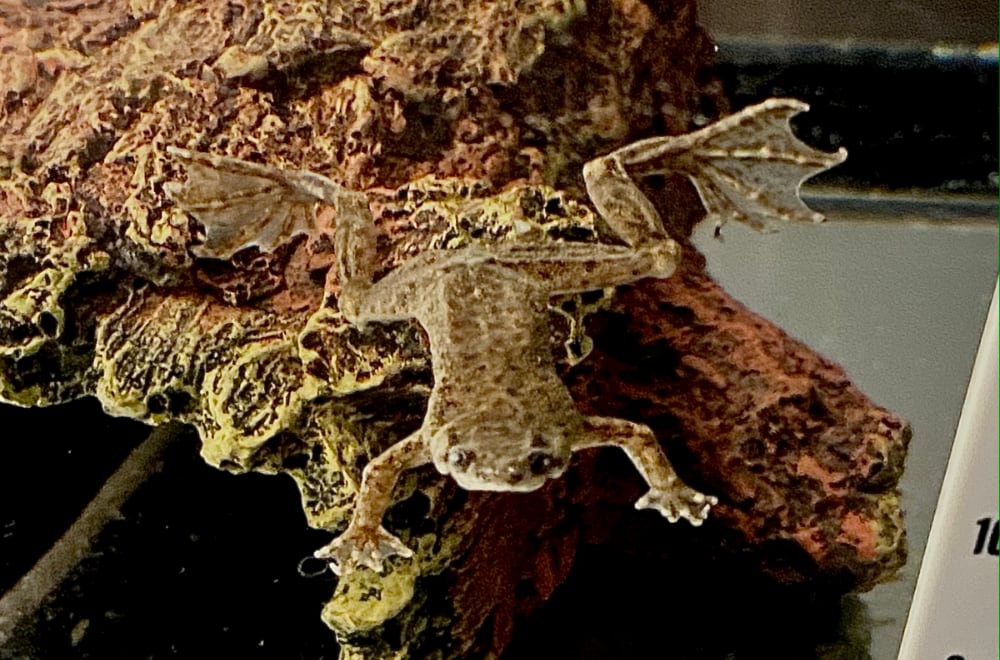When people hear the word frog, they picture a giant green frog with bulgy eyes hopping through the grass. Or perhaps perched upon a tree branch croak
When people hear the word frog, they picture a giant green frog with bulgy eyes hopping through the grass. Or perhaps perched upon a tree branch croaking at the edge of a stream. That was how I pictured frogs before I was introduced to African dwarf frogs for the first time and started raising them five years ago. Although these unique and fascinating creatures have made their way into the common pet trade over the past 40 years, they are still less commonly known than bullfrogs, treefrogs and toads. For those of you out there who are considering adopting an African dwarf frog and want to give it the proper care it needs to live a long, happy, and healthy life, here is some helpful information to get you started.
The Origins of the African Dwarf Frog
African dwarf frogs were first discovered in rivers, streams, puddles, and shallow ponds in various regions throughout Central Africa in the late 19th century. They are members of the Hymenochirus genus of aquatic frog species and are easily confused in appearance with the other frog species in their group, the African clawed frogs. While these fully aquatic amphibians both belong to the Pipidae family and may appear to look similar, they do have different physical and behavioral traits, which are important for beginner African dwarf frog owners to identify prior to adoption.
Identifying Male and Female African Dwarf Frogs
There are several distinct features that make it easy to identify male and female African dwarf frogs. Male African dwarf frogs are typically smaller in size as they mature, develop small glands behind their front legs called post-axillary subdermal glands, have a small tail, and “buzz” quite loud when they are excited or trying to attract their mates. Females are typically larger in size with pear-shape bodies as they mature, develop longer tails, and aren’t known to buzz. When the males buzz, it is typically at night when they are most active. African dwarf frogs are nocturnal. In the wild, they hunt for food at night and rest during the day.
Choosing The Right Aquarium For Your African Dwarf Frog
The size of your aquarium will depend on how many African dwarf frogs you would like to raise. Since they are very small frogs and only grow to a maximum of 3 inches, a 2.5-gallon aquarium is recommended for housing one African dwarf frog. A 5-gallon aquarium is recommended for housing two, and a 10- to 20-gallon aquarium is recommended for more than two. Although African dwarf frogs are fully aquatic, they have lungs and need to rise to the surface of the water frequently for air. Their webbed feet make it difficult for them to swim in deep water. Avoid placing them in aquariums that are more than 12 inches deep. If their aquarium is too deep, they will struggle to reach the top for air and drown.
African Dwarf Frog Tank and Accessories Checklist
Tetra Glass Aquarium
Stoney River Cherokee Pebble Premium Aquarium Gravel, 5-lb bag
Tetra HT10 Submersible Aquarium Heater & Electronic Thermostat, 50-watt
API pH Freshwater Aquarium Test Kit, 250 count
Lee’s Aquarium & Pets Under Gravel Aquarium Filter
Tetra LED Aquarium Hood
API Tap Water Conditioner
Zoo Med Aquatic Frog & Tadpole Food, 2-oz jar
Setting Up Your African Dwarf Frog Aquarium
As with all herps, maintaining a proper living environment for your African dwarf frog is key to preventing stress, disease and a shortened life. The following tips for properly setting up and maintaining their living space are highly recommended:
- Maintain water temperatures between 72-78 degrees Fahrenheit. The water should be similar temperatures to the African dwarf frog’s native habitat in Africa. A submersible heater and a digital thermometer are essential for maintaining these temperatures.
- Maintain PH levels between 6.5 – 7.8. These levels can be monitored regularly using PH testing kits.
- Use large aquarium gravel to cover the bottom of the tank. Gravel comes in different sizes and colors. If the grains are too small, the frogs can accidentally consume it and have a difficult time digesting it. This could lead to impaction and can be fatal. Sand is another option for substrate. It is recommended that a substrate be used in any aquarium, but some African dwarf frog keepers opt out of using substrate in fear of their frogs consuming it. It is a personal choice, but substrates make it easier to secure live and artificial plant decorations in the aquarium.
- Always secure the aquarium with a lid. African dwarf frogs spend their whole lives underwater and are not capable of surviving on dry land for more than 15-20 minutes. If they escape, their skin will dry out and they will not survive. Be mindful that African dwarf frogs require oxygen at the water’s surface, so it is best to use a screen lid. If you use a solid lid, make sure it remains open a crack so that your frog can access air to breathe.
- Avoid the use of large filters. African dwarf frogs are very sensitive to noise and they don’t have ears. They use the lateral lines on their bodies to sense vibrations. Large filters can induce stress and sickness. These frogs also prefer motionless water, so make sure the filters don’t cause strong water currents in the aquarium. An under-gravel filter is recommended. Always check with an aquarium specialist online or in store if you are uncertain. If the aquarium is small and maintained regularly, African dwarf frogs can do just fine without one.
- Provide 10-12 hours of aquarium lighting daily. African dwarf frogs are nocturnal and require a regular day and night cycle. They don’t need UVB lighting like many reptile and amphibian species do. A basic LED hood light is sufficient. Avoid placing the aquarium in a room without windows. Rooms with natural sunlight will work just fine too.
- Use filtered water in the aquarium. Raw water contains harmful chemicals such as chloramine and fluoride that can be toxic to all aquatic species. If you use tap water, be sure to treat it with anti-bacterial supplements and water conditioners prior to placing the African dwarf frog back in. Avoid the use of soap to clean the aquariums. Soap can leave residue in the aquarium and make the frogs sick.
- Perform water changes bi-weekly. It is best to change at least 10-25% of the water every 2-4 weeks. If a filter is not being used, then it is best to change the water at least once a week. Frogs shed and can be messy eaters. Avoid performing full water changes. This could cause stress and fatally shock African dwarf frogs.
- Avoid aquarium décor that is sharp and toxic. African dwarf frogs are hunted in the wild and require places where they can hide out in such as caves or logs. African dwarf frogs do well with artificial or real plants, but plants with sharp edges can tear at the frog’s skin. Some wood décor can contain harmful toxins that increase PH levels in the water. Always check with an aquatic specialist online or in store if you’re uncertain about which decorations to use.
Foods To Feed Your African Dwarf Frog
An African dwarf frog’s diet should contain a high protein and well-balanced selection of food consisting of specialized aquatic frog sinking pellets, freeze dried bloodworms, frozen brine shrimp, daphnia, and live blackworms. African dwarf frogs have poor vision and rely on their sense of smell and touch to eat. They have no tongues or teeth to help them chew, so the food that they consume should be cut up in small pieces and fed to them in small portions.
They can be fed off a ceramic terra cotta plate inside the aquarium, or hand fed from a pair of tweezers. Since their vision is very poor, their food should be dropped in front of them so they can use their senses to find it quicker. It is best to feed them in the evening as this is when they hunt for food in their native habitats. Their stomachs are tiny, so feeding them once a day or every other day is best for their digestion. Any leftover food in the aquarium should be scooped out as soon as possible to prevent the water from getting dirty. Overfeeding could lead to stress, disease, and excessive waste build up in the water.
When selecting food, be sure to read the labels on the containers prior to purchasing them. They should be aquatic frog specific and contain at least 40-50 percent protein. Zoo Med, Josh’s Frogs and Omega One are some of the manufacturers that offer foods specific to African dwarf frogs.
Choosing the Best Tankmates for Your African Dwarf Frog
African dwarf frogs may be peaceful and non-aggressive frogs, but not all freshwater species feel the same way about them. If you are considering keeping your African dwarf frog with other freshwater species, the following 10 aquatic species make the best African dwarf frog tankmates:
- Guppies
- Cardinal Tetras
- Honey Gourami
- Bettas
- Zebra Danios
- Cherry Barbs
- Corydoras
- Mollies
- Shrimp (Cherry or Bamboo)
- Snails
When housing African dwarf frogs with their tankmates, be sure that the aquarium is not overcrowded and there is enough swimming space for them to thrive peacefully. Adequate space will help maintain a stress-free living environment. Although these tankmates are the most compatible with African dwarf frogs, Betta fish can become aggressive and territorial if they lack swimming space and feel threated by their tankmates. Always check with an aquatic specialist online or in store if you are uncertain. African dwarf frogs can be housed with other African dwarf frogs of both sexes.
Signs of a Healthy and Unhealthy African Dwarf Frog
It is important to be able to identify the signs of a healthy and unhealthy African dwarf frog before you purchase them and while they’re living their lives at home in the aquarium.
Signs of a healthy African Dwarf Frog include:
- actively swimming around the aquarium
- hiding often in their aquarium hideaways
- clear eyes and skin
- swimming away from capture
- interactive with their owners and tankmates
- consuming their food quickly and regularly
- spending most of their time at the bottom of the aquarium
Signs of an unhealthy African dwarf frog include:
- loss of appetite
- cloudy/puffy eyes
- bloated stomachs
- unresponsive to their owners and tankmates
- reddish/pink patches on their legs
- white fuzzy patches or spots on their skin
- excessive floating at the top of the water
- easily captured
- weight loss
With proper care, African dwarf frogs can live between five and 10 years in captivity. Some are known to have lived 10 to 15 years.
Zen Position
African dwarf frogs can be seen floating around at the top of the water periodically with their arms and legs stretched out. Rest assure that this is just their way of being lazy and is perfectly normal behavior. This is called, the Zen Position. If they appear to be doing this constantly and are unresponsive to feeding time or any other type of interaction, this could be a sign that they are sick.

Two African dwarf frogs. Photo by Dan Olsen/Shutterstock
Shedding
African dwarf frogs typically shed their skin two to three times a month. Before they shed their skin, their bodies will appear whitish. African dwarf frogs shed their skin for various reasons. The main reason is because of their natural growing process. If you see them eating their shed afterwards, this just means that they are consuming the leftover nutrients they lost during the shed. It is perfectly normal, so the shed can be left in the tank. They can shed for unhealthy reasons also, which could be due to fungal infections, poor water quality or drastic changes to water parameters. Be mindful of this when you perform water changes, feed your frog, or add specific substrates and decorations to the aquarium.
If they are shedding more than a few times a month, there could be a water quality issue going on. Healthy shed should appear white and come off almost entirely in one piece. Unhealthy shed will appear discolored and come off in little flakes. Sometimes the frogs will struggle to get the unhealthy shed off. Another sign of unhealthy shedding is if the frog’s skin doesn’t return to its natural dark shade once the shed comes off. If their bodies still appear white, then this is a sign that your frog is sick.
Purchasing African Dwarf Frogs
African dwarf frogs cost anywhere between $1.99-$3.99 and can be purchased at your local fish store or online.
African Dwarf Frogs and Salmonella
African dwarf frogs can carry diseases on their bodies such as Salmonella, which can be transmitted to humans if they are handled in an unsafe manner. Wearing gloves and washing your hands before and after handling them or any amphibian and reptile is the best way to avoid catching any diseases.
Although they are very friendly and make great pets, children especially should be supervised while interacting with African dwarf frogs. For more info on Salmonella prevention, visit https://www.cdc.gov/healthypets/pets/reptiles/safe-handling.html.
Lana Van De Mark has been raising African dwarf frogs for the past five years and has a six-year-old male African dwarf frog named Franklin.




